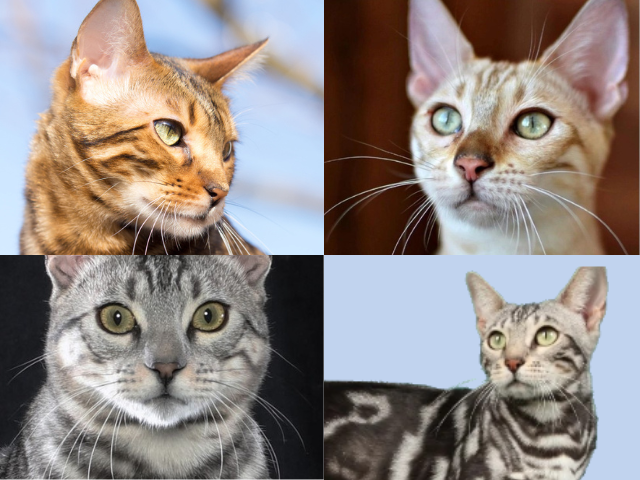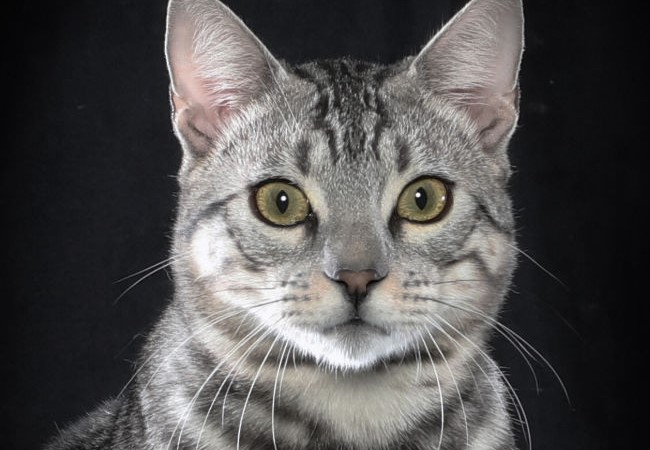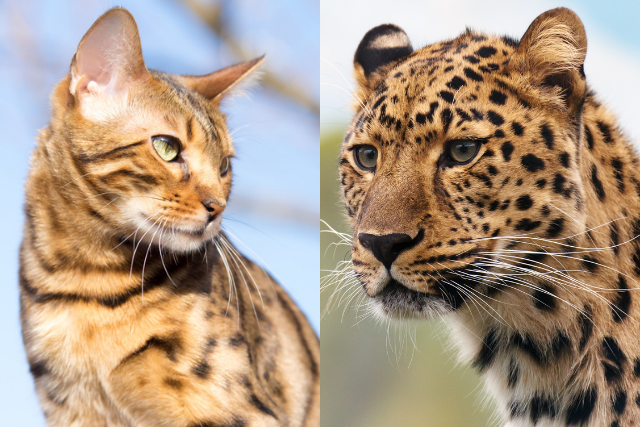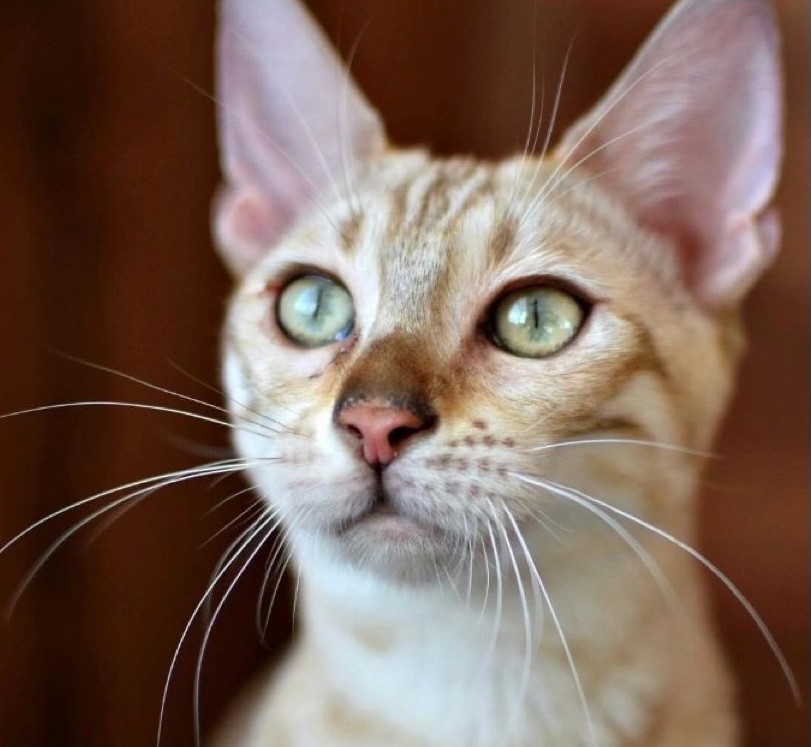Bengal cat types are increasingly becoming more diverse.
Bengals are one of the relatively new cat breeds having only been accepted by The International Cat Association (TICA) in 1983.
Selective Bengal breeding programs have introduced a variety of fur patterns and colours.
Many of these of replicate the look of their ‘big cat’ cousins.
This beginner’s guide takes you through the types of Bengal cat you will find if looking for a pet or for show purposes.
What You Will Discover
- The fur patterns and markings carried by Bengal cats
- The variety in Bengal cat types with regards to base coat colour
- The typical size and life expectancy of a Bengal
Bengal Fur Patterns
Fur patterns found on Bengal cats fall into two main, ‘officially recognised’ types:
- Spotted
- Marble
Spotted Bengal cat types are more sought after than marbled and will in general cost more (see Prices of Bengal Cats: The Definitive Global(ish) Guide 2021).
Bengal breeders have taken the spotted pattern and attempted to diversify it into more complex rosettes that resemble ‘big cats’ and fit a breed standard- which is only of concern if you want to win big at shows.
For the rest of us, it’s likely you’ll see or own a Bengal cat which has some elements of the seven patterns listed below:
- Single Spots
- Arrowhead Rosettes
- Paw Print Rosettes
- Doughnut/Donut Rosettes and Pancakes
- Clouded Rosettes
- Cluster Rosettes
- Embryonic Rosettes
Now that we know the different categories, let’s explore each further starting with the pattern my Bengal kitten has running across her belly…
Spotted Bengal Cats
Single-Spots
Single-spots are common amongst Bengals.
These are spots/blobs of a uniform colour that contrast with the background coat.
Chances are, Bengals sold as pets will have a good few of these on their body.

The big cat equivalent would be the markings found on a Cheetah.
Single-spots are abundant.
Not so much the next pattern…
Arrowhead Rosettes
Arrowhead rosetted Bengals are considered highly desirable in the Bengal breeding community as well-defined examples are rare.
As the name implies, the rosettes form a triangular ‘arrowhead’, with the tips facing away from the cat’s head and pointing towards the tail.

They too can be all one colour, like single-spots, or have a darker rim with a lighter second colour that fades into the main coat.
Arrowhead coat patterns can be found on some Asian leopard cats, which of course, were originally crossed with domestic cats to create the Bengal breed.
We’ll now look at a pattern that is an attempt to reflect a more commonly known big cat…
Paw Print Rosettes
No points for guessing what these are supposed to resemble.
Yes, paw print Bengal rosetted patterns are formed by a lighter patch of fur (the ‘paw pad’) surrounded by darker ‘toes’.

These ‘toes’ are distinct and have visible distance between them, although they don’t actually form a genuine paw pattern, well not from any animal I’ve seen anyway…
The aim by Bengal breeders here is/was to replicate in miniature, the markings of a Leopard.
The next rosette type is ‘sweet’…
Doughnut/Donut Rosettes and Pancakes
Doughnut or donut rosettes (depending on where in the world you’re from) are a recent development in the Bengal cat coat world, taking years of selective breeding to achieve.
They too have a lighter central patch, but differ to paw print rosettes in that they have a darker perimeter which encloses the lighter patch (as opposed to ‘dark toes’).

This perimeter may not fully close the central patch, but any gaps are much narrower than those on a paw print rosette.
Doughnut/donut rosettes can form linked, horizontal chains- so- called ‘chain rosetting’.
These run along each side of the cat’s spine and good examples are found in Ocelots.
Pancake rosettes differ to the doughnuts/donuts in that are generally larger but have a thinner outline.
Jaguars were the template for this pattern.
The final of the major rosetted Bengal cat pattern types is arguably the strangest of all….
Clouded Rosettes
The Bengal rosetted pattern featured here is more unusual in that it doesn’t really look like something you would call rosetted at all.
This category comprises of larger, less numerous, stretched ‘clouds,’ many of which have a thicker, darker rim on one edge.
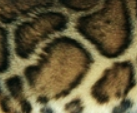
There is also less spacing (known in the business as ‘acreage’) between each.
Breeders here aim to create rosetted Bengals with the pattern found on the coat of the Clouded Leopard, which is one of the smaller-sized of the big cats.
You’d be forgiven for mistaking the pattern I’ll cover next for one already discussed…
Cluster Rosettes
These are similar to the aforementioned paw print rosettes.
As with paw print, they consist of a darker, pad-like patch surrounded by darker spots.
The key difference, although I’ll admit, I found it hard to tell with some of them, is that cluster rosettes have a darker spot within the pad and the surrounding spots are dotted around the outside in clusters (without the ‘open end’ you would see on a paw print’).
The final category didn’t feature much at all in my research, but is still worth a mention…
Embryonic Rosettes
Embryonic rosettes are essentially spots with that show a second colour (or true rosette) beginning to form.
The example I found was that of an embryonic arrowhead, as shown.

Now from spots to marbles…
Marbled Bengal Cats
Although marbled Bengals aren’t considered as desirable as their rosetted counterparts, it is from marble Bengals that the rosetted kind descended.
The marbling pattern is essentially made up of stripes that swirl and align horizontally.
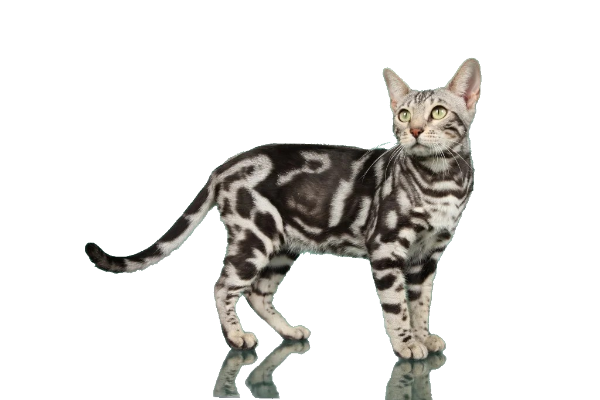
There are four officially recognised Bengal cat marble types.
These are horizontal flow, reduced horizontal flow, sheet marble and the chaos pattern.
Swirls can consist of two or more colours from black, brown, gold, cream and rufus (a brownish red)
Swirls that flow vertically can give rise to an undesirable feature known as a ‘bullseye’ owing to its resemblance to the centre of a target.
But what do you call a Bengal with both spots with marbles?
Sparble
Yes, there are Bengal cat types with this fur pattern.
Sparble Bengals display both rosettes and marble fur patterns to varying degrees.
They aren’t officially recognised (not that they’d care I imagine) and despite having both patterns, are considered to be spotted cats.
Now onto the different base coat colours you will come across…
Bengal Fur Colours
Although there are only three officially accepted Bengal breed colours and their sub-categories, you may come across many more as breeding increases the pool.
Brown, silver and snow are the recognised Bengal cat coat colour types, but we will also discuss others including black and blue Bengals.
Brown
The Asian leopard cat crossed with domestic cat breeds gave rise to the brown Bengal.
Brown is the most prevalent colour and was the first to be recognised by TICA.

Of course brown is actually the umbrella term for fur colours that can be darker, lighter, redder or more golden.
You will see many brown Bengals with a white or ‘creamish’ underside as this a trait desired by breeders (and is also found in the Asian leopard cat).
Patterns, that is, spots/rosettes or marbles are much darker than the base fur colour and range from black to light brown.
Other features typical of the brown Bengal include:
- Golden/Brown, green and hazel eyes
- A Tail with a black tip
- A Red/pink nose
Next up, snow Bengals…
Snow
Snow Bengals first came into being after a Siamese cat was introduced into a Bengal breeding program.
The Bengal gene pool has been enlarged further by adding some genetic information from Burmese cats.
This meant snow Bengals split into the 3 distinct types:
- Snow Seal Lynx
- Snow Seal Mink
- Snow Seal Sepia
Seal is a shade of brown- seal brown in effect.
Therefore ‘seal point’ means the cat has a solid shade of brown in ‘pointed areas’ (which is duscussed below).
Snow Seal Lynx
Generally considered to have the whitest or palest fur of all the snow Bengals, the seal lynx Bengal is also referred to as the ‘Seal Lynx Point’.
The darker face, tail, feet and ears are features called pointing.
This trait was inherited from the Siamese breed, albeit in a less pronounced fashion.
The ‘Lynx Point’ part of the name refers to the fact that the ‘pointed’ areas on the cat’s body have tabby/striped markings.
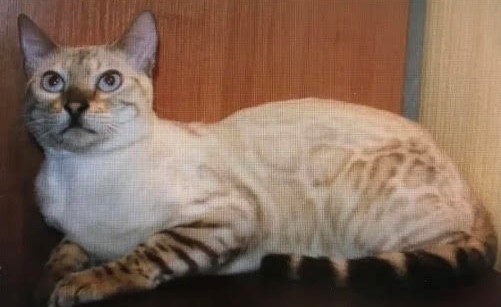
Lynx Bengal kittens are born completely white, and only after a week or so do they start developing their contrasting darker colours.
After some months a kitten’s true and final colouring appears, and this can be a light brown/tan which can almost look orange around the nose.
Unique to the seal lynx snow Bengal is eye colour as it the sole owner of blue eyes.
Again, it has it Siamese genetic history to thank (or not if it doesn’t like them…)
Expect to find snow lynxes with a pink nose.
Instead of the Siamese, our next snow Bengal variant can attribute some its look from a different cat breed…
Snow Seal Sepia
The introduction of the Burmese lead to a specimen with a greater contrast in markings and base fur.
It is also considered to look most like the Snow Leopard.
This is because seal sepia snow isn’t pure white– and neither is a Snow Leopard.
Think about how a Snow Leopard’s coat will offer camouflage in a snowless, grey, brown rock-strewn environment.
Sepia’s have acquired the nickname ‘snow brown Bengals’ but neither are they truly brown- simply that little bit darker.
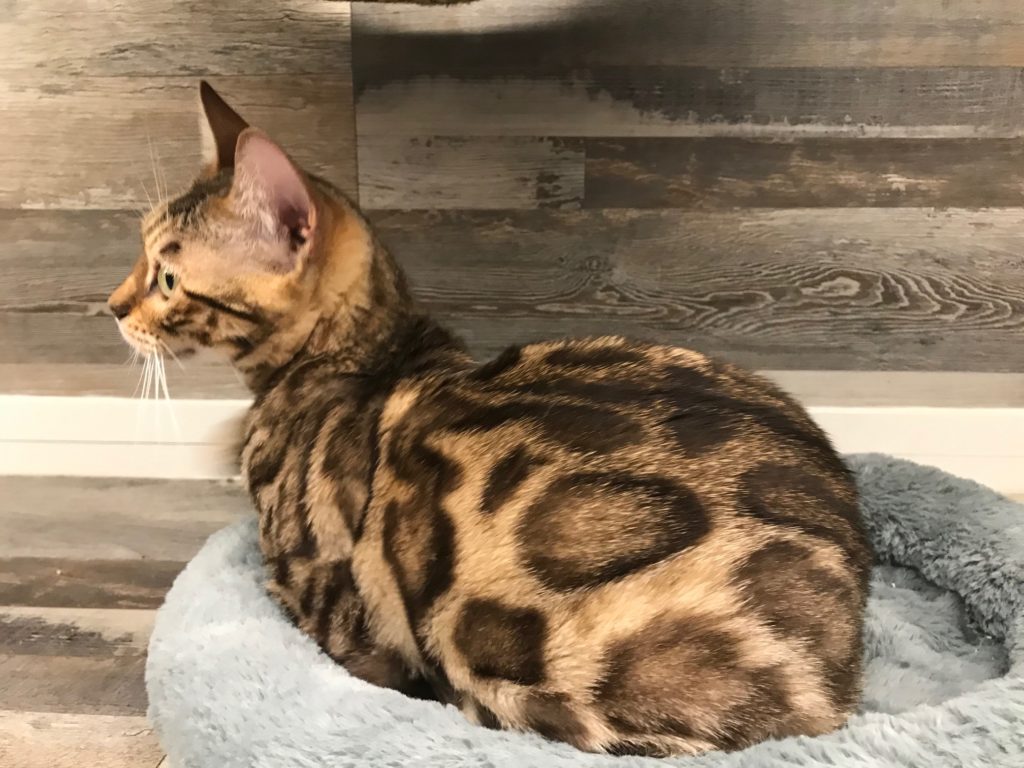
Instead, their base coats are cream, beige or light tan coloured with markings that are sepia brown or darker.
Sepia Bengal kittens display these marking from birth- hence this is a way of telling them apart from the snow lynx.
A sepia snow Bengal will have green or golden/orangey eyes and a light pinkish nose.
Our final snow variant is a bit of a melting pot…
Snow Seal Mink
The mink snow Bengal is quite literally a mix of the lynx Bengal and the sepia in that they carry BOTH the Burmese and Siamese genes.
In terms of colouration then, this typically puts this Bengal cat somewhere between the two.
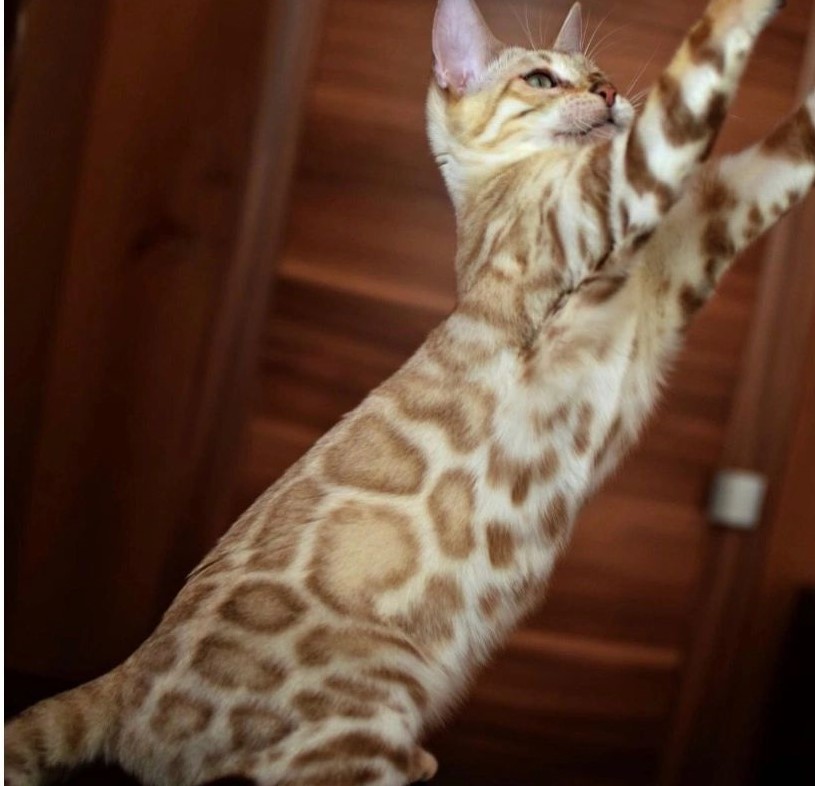
Snow minks are darker than their seal lynx kin, but not as dark as the sepias.
Look out for a white, cream very light brown coat, with light brown markings that darken with age.
Mink Bengal kittens have a fur pattern visible from birth.
A seal mink snow will usually have blue-green/aqua eyes but they can also be gold.
Expect a mink Bengal to have a dark pink or reddish nose.
With brown and white covered, the last ‘official’ colour is silver…
Silver
Silver didn’t start appearing as a base coat colour in the Bengal cat breed until the 1990s.
It was introduced after a cross between a brown Bengal and a silver cat– believed to be an American Shorthair, although I have also seen an Egyptian Mau mentioned.

It’s important to note that the original brown colour in silvers is only inhibited (by an inhibitor gene) and not entirely removed.
This visible effect is called ‘tarnish.’
There are four main groups that come under the umbrella of ‘silver Bengal’- with one of these groups subdivided further.
Silver Snow
These are snow Bengals that carry the silver Bengal inhibitor gene mentioned earlier.
When young, it’s said to be hard to visually distinguish between a snow Bengal kitten and a silver snow.
But as they age, the silver/grey background fur of the latter becomes more distinct.
The snow variants then, if they carry the silver Bengal inhibitor gene become:
- Silver Seal Lynx
- Silver Seal Mink
- Silver Seal Sepia
They essentially have a similar look to snows, BUT with more of a grey/silver look to them.
Obviously.
Now from light to dark(er)….
Black/Melanistic
The Bengal cat equivalent of a panther would be the black or melanistic Bengal.
They are not truly black however as patterns, albeit still dark, can still be visible.
These marking are much harder to see and are therefore termed ‘ghost markings’.
Silver Bengals with black/melanistic colouring are called ‘Silver Smokes.’
Black Bengals are rare and not officially recognised.
Be warned as things are about to turn blue…
Blue
Blue Bengals are rare owing in part to the fact that the traits displayed by a blue Bengal are carried by a recessive gene– that is, both parents must carry it in order for the characteristics typical of blues to be seen.
These cats, as you would expect, have a bluey/grey coat with cream, beige or peach under tones.
Fur patterns consist of dark blue or grey colours.
Other features of note include:
- Gold, hazel or green eyes
- A tail with a dark grey tip
One may find silver blue Bengals, which have lighter undertones and understandably are more silver looking.
Now as Amy Winehouse once sang, it’s back to black… well charcoal…
Charcoal
The charcoal trait is passed down independently of colour.
This means you can find it in browns, silvers, snows and blues.
It can be hard to distinguish between charcoal and black/Melanistic Bengals.
This is because charcoal patterns can very closely match background fur making charcoals appear as having only one solid colour.
Charcoal Bengals have a unique element of patterning- the ‘Zorro mask and cape’ (like the silver charcoal below).

These are a black face ‘mask’ which leads into an equally dark ‘cape’ running along the back. Sword not included.
Other features include a dark, black tipped tail with stripe patterns.
Having covered colouring, there are some other coat features you may come across when looking at Bengal cat types.
Other Bengal Fur Features
Glitter
Bengal fur can sparkle in a rather unique manner.
This Bengal ‘glitter’ effect is caused by light reflecting off individual hairs that are both hollow and translucent.
Not all Bengals will possess a coat that shines in this manner.
Patina and Ticking
These are visual elements Bengal fur I had not heard of until researching this article.
Patina is an effect that occurs when hairs with dark tips cause Bengal patterning to look blurred or ‘dark washed’ over the shoulders and back.
Ticking is patina but on a grander scale, that is, all fur patterning looks blurred.
Instead of just dark tips creating this effect, multi-coloured hairs create a faded look that lacks contrast.
Bengal Fur Length
By far the most widespread throughout all colour types and patterns are the short-haired Bengals.
Their fur tends to shed less readily than other breeds, which is why some claim them to be hypoallergenic.
However, this isn’t the case. (See ‘Are Bengal Cats Hypoallergenic? 5 Big Myths Explored.‘)
Short-haired Bengal fur is typically smooth, silky and pelt-like.
Perhaps unsurprisingly, long- haired cats have started to make an appearance although they are not officially recognised by the associations.
These have taken on the name ‘Cashmere Bengals,’ as they still have silky smooth fur, but longer.
Other Shared Bengal Cat Traits
Whether a brown spotted or a silver marble Bengal cat, the following are consistent across the colour spectrum:
Size
Most adult Bengal cats weigh between 6-15lbs (2.7-6.8kgs), but some specimens have been known to reach the 20lb (9kg) plus mark.
Expect a Bengal cat length of up to 18 inches (45.7cms) for fully grown adults (excluding the tail).
A Bengal cat height (that is, based on what I could find, from the base of front paw to top of the head- ignoring ears) is around 15 inches (38cms).
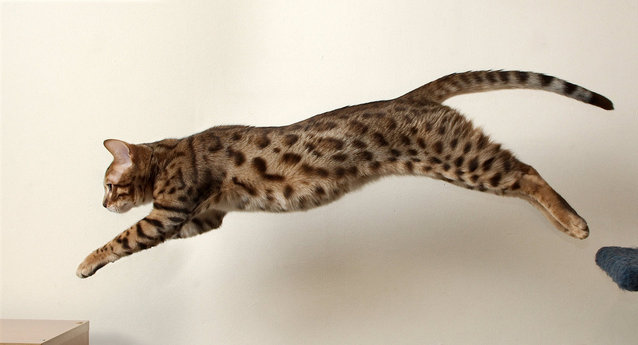
In most species, the male is bigger than the female and in Bengal cats, this is no different.
Therefore adult male Bengal will tend to be at the upper end of the weight range and on average come in somewhere between 10-15lbs (4.5-6.8kgs).
The biggest are those in excess of 20lbs (9kgs), thanks to all that extra muscle.
In comparison to their male counterparts, female Bengals are usually smaller and you’re very unlikely to find a specimen on par with the largest males.
With that in mind, expect your female Bengal to weigh between 6-10lbs (2.7-4.5kgs).
So how long do male and female Bengal cats live for?
Life Expectancy
The life expectancy of Bengal cat ranges from 12-20 years with an average of around 15 years.
These figures do vary slightly according to what you read.
Much can be done to give a Bengal a chance of reaching the 20 year mark- for some actionable ideas, please read ‘How Long Do Bengal Cats Live? 12 Excellent Ways To Boost Life Expectancy.’
Types of Bengal Cat Summary
The Bengal cat breed has diversified considerably since the original crossing of an Asian leopard cat with a domestic breed.
Brown Bengals remain the most common.
Silver, Snow, Black and Blue Bengals plus their variants have diversified the breed further, although not all of these are formally recognised.
Those with rosettes are more sought after than marbled.
Even long-haired varieties are now cropping up.
Despite there being visual differences, all Bengal cat types will fall within a certain size range and life expectancy.
So which do you wish to find out more about?
My thanks to Dawn Schwiebert from Exotic Bengals of San Diego for providing the snow Bengal photos seen in this article.
Also thanks to Diane from ValleyKatz Bengals for allowing use of many of the silver Bengal images.
Silver Bengal in featured image by Jim Harris.
Further Reading:

